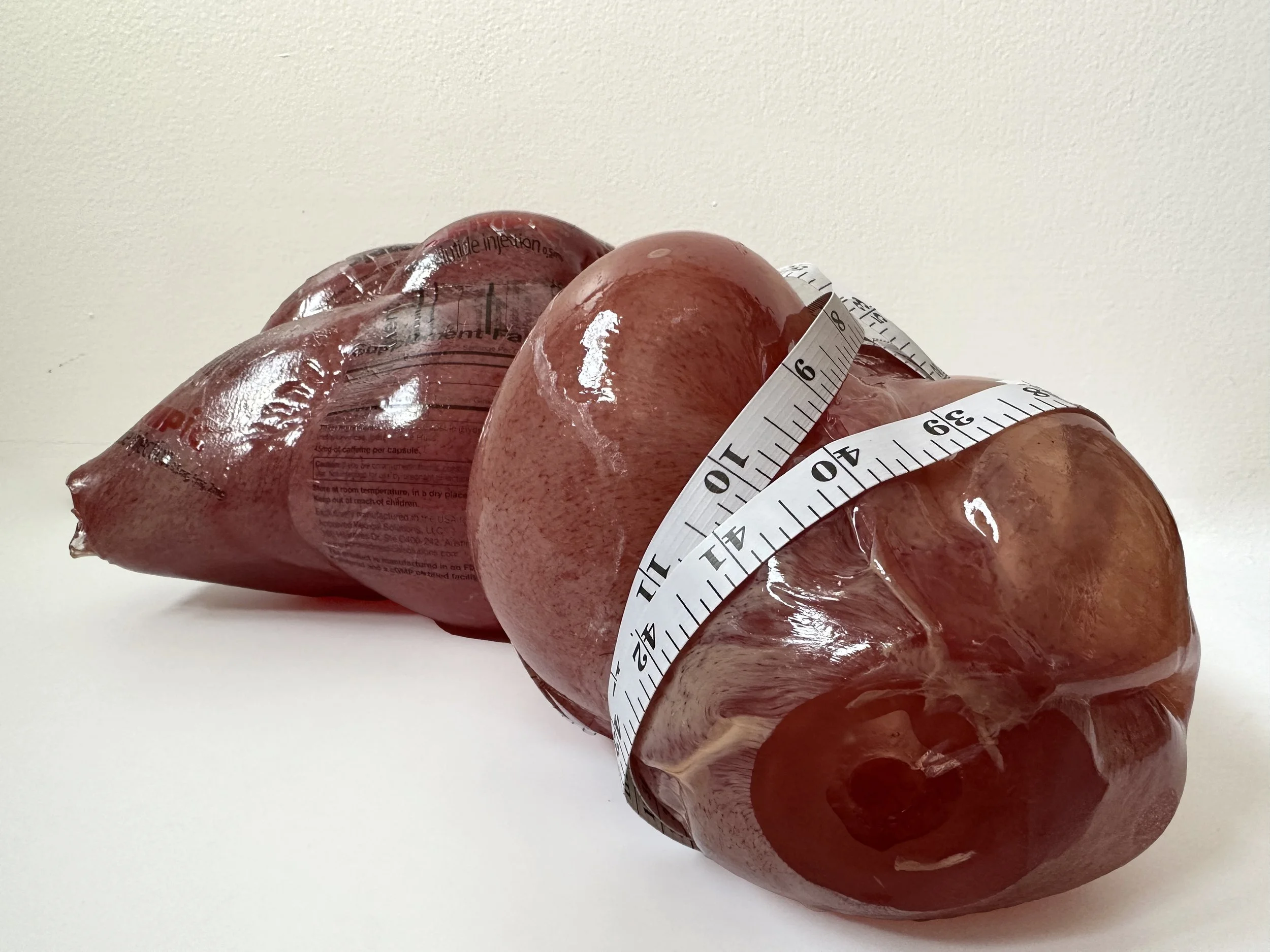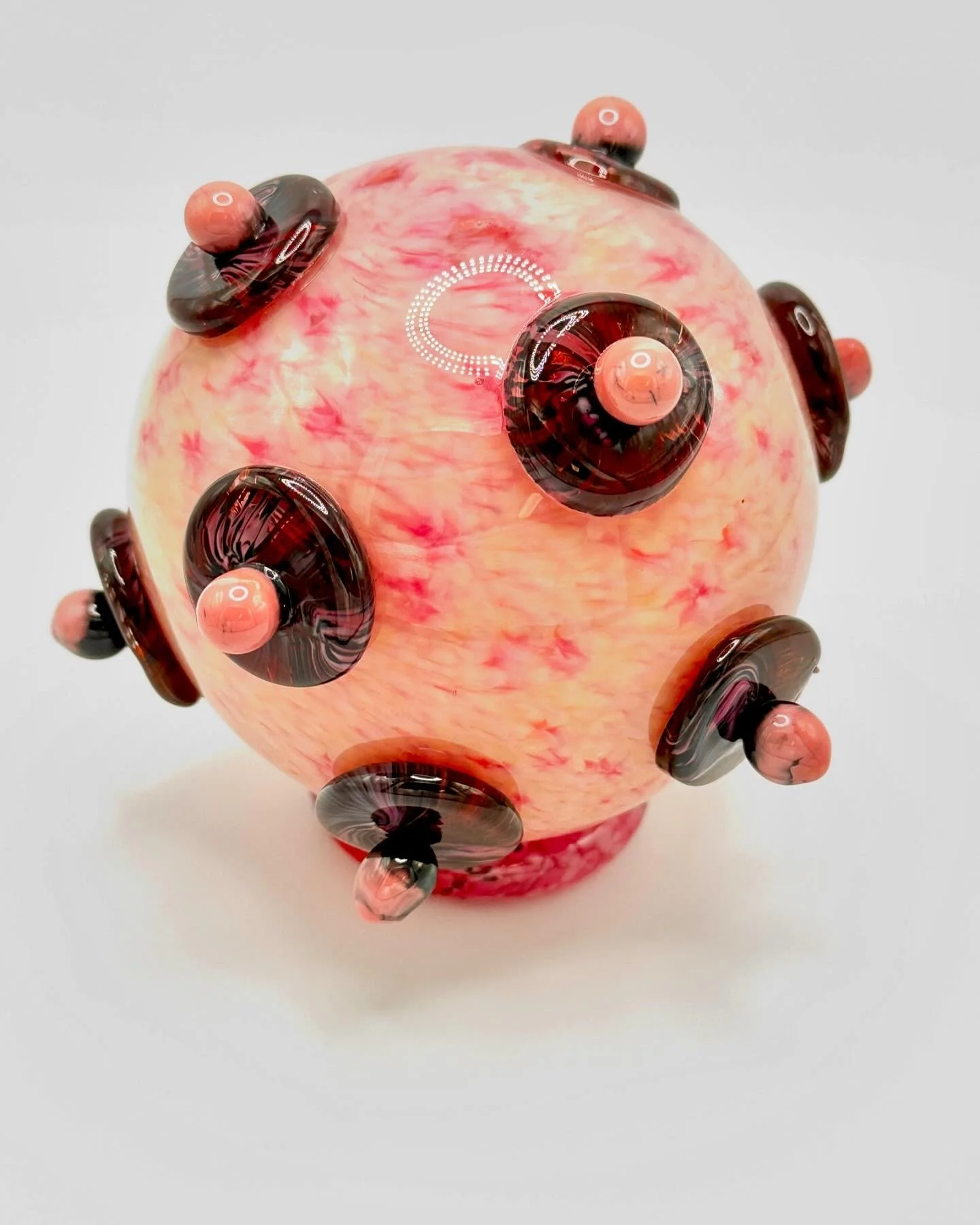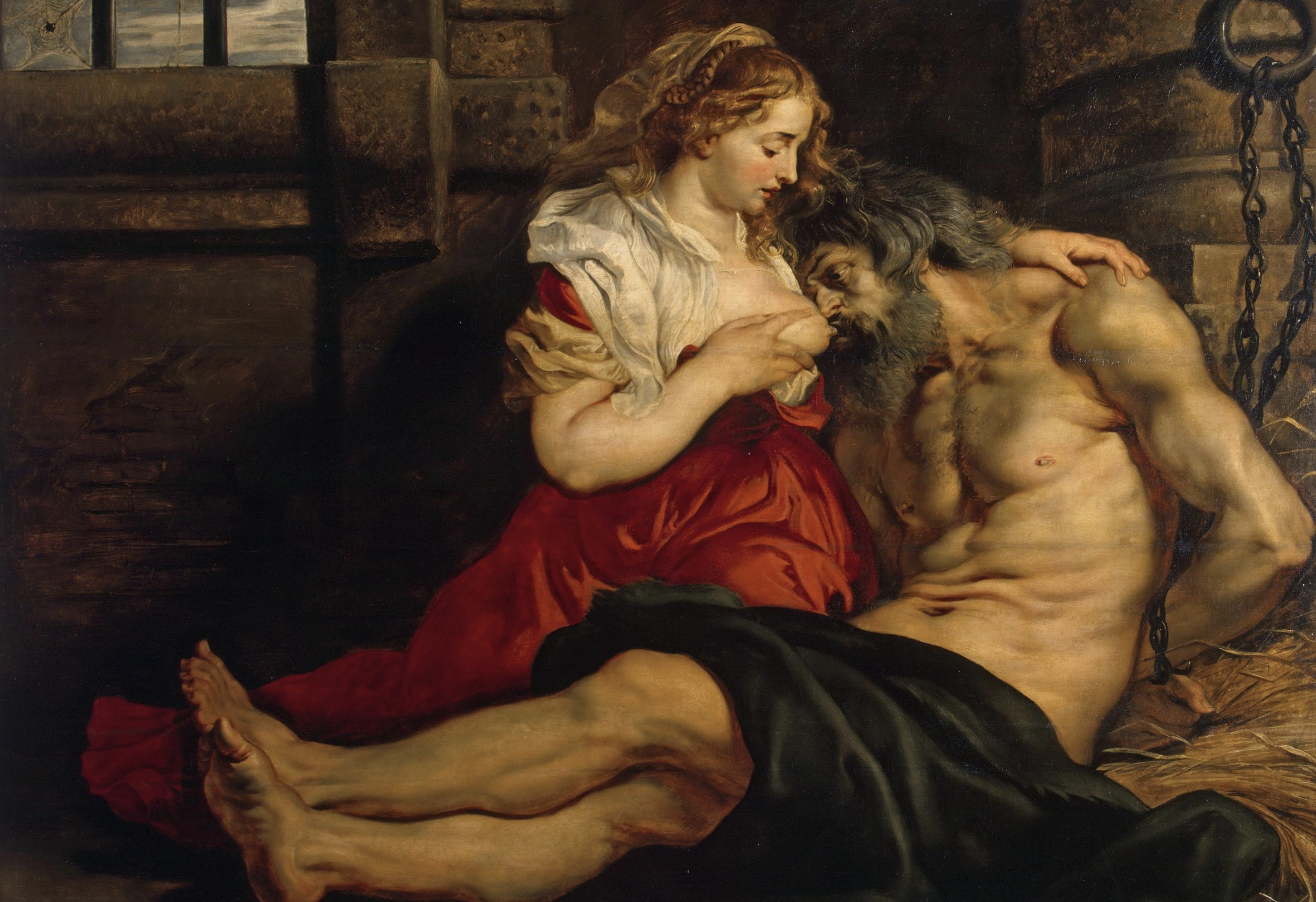GLASS ART
Pound of Flesh is a sculptural diptych made from hot-sculpted glass that explores the emotional and physical toll of fatphobia, the false promises of weight loss, and the medicalization and commodification of fat bodies. The two pieces resemble fleshy, skinless folds of fat and muscle—distorted, raw, and unsettling in their vulnerability. Their meat-like appearance evokes both the dehumanizing clinical gaze and the internalized belief that fatness is something grotesque to be trimmed, cut away, or hidden.
One of the forms is encased in the drug facts for Ozempic, a medication increasingly prescribed for weight loss, even among non-diabetics. The water slide decals cling to the surface of the sculpture in a way that mimics plastic wrap—wrinkled, slick, and slightly opaque. This treatment evokes the visual language of meat on display at the grocery store: neatly packaged, priced, and ready for consumption. This reference turns the body into product—something to be measured, evaluated, bought, sold, and altered. It speaks to the cultural obsession with weight loss, where fat bodies are not seen as people, but as problems to be fixed, marketed to, and made more palatable.







The second sculpture is tightly bound in fabric measuring tape, a futile and constrictive gesture that recalls the ritual of dieting, of squeezing, of trying to contain and control the body. When displayed side by side, these forms offer a visual narrative of weight cycling: one large, unruly, uncontained; the other shrunken, but still distorted and marked by restriction. Nothing changes but the size—never the scrutiny, the shame, or the sense of bodily failure fat people are taught to carry.
Glass itself serves as an essential metaphor in this work. It begins hot, moving, pliable—full of potential and agency. But as it cools, it becomes fixed, reflective, and fragile. It holds the memory of what shaped it, just as our bodies carry the marks of dieting, surgery, control garments, and shame. The same material that once flowed with possibility becomes rigid under pressure. In this way, Pound of Flesh speaks to the trauma of being molded by external expectations and the lasting damage of being forced into conformity.
This work resists the narrative that fatness is a problem to be solved. It refuses the tidy before-and-after story and instead centers the truth: that shrinking a body does not erase the pain of being policed, judged, and diminished. Pound of Flesh is a reckoning—a tribute to the scars, both visible and invisible, that fat people carry, and a call to honor our bodies as they are: complex, capable, and worthy.
"Maiden Mother Crone" is a glass vessel that draws upon the symbolism of the Triple Goddess from paganism and witchcraft, exploring the phases of a woman’s life—Maiden, Mother, and Crone. Each of the three breasts on the vessel represents these stages: the youthful pink nipple of the Maiden symbolizes fertility and desire, the red nipple dripping milk evokes the nurturing role of the Mother, and the sagging, wrinkled breast of the Crone reflects the often-dismissed wisdom of age. Together, these breasts form a narrative about the cycles of life, femininity, and the shifting perceptions of women’s worth.
The fig-colored glass, with its rich associations of fertility, sensuality, and abundance, deepens the connection to womanhood. Figs have long symbolized fecundity and the feminine, their lush shape and soft interior evoking ideas of nourishment and growth. Just as a fig holds seeds within its protective skin, the vessel suggests layers of meaning, experience, and potential. The narrow opening of the vase deliberately questions functionality, subverting expectations of how a vessel—or a woman—should serve.
As a functional vase, the piece critiques the societal tendency to tie women’s value to their ability to serve or be useful. The Crone, often dismissed because she is seen as no longer functional, is here honored and reclaimed. The addition of fake flowers—a rosebud, a fully bloomed rose, and a wilted rose—mirrors this commentary. These symbols reflect the way women’s beauty and value are judged in stages, from the desirable Maiden, to the nurturing Mother, to the Crone, who is often overlooked when her beauty fades and her perceived usefulness diminishes.
The work also references the history of the Maiden Mother Crone in witchcraft, a spiritual archetype long feared and suppressed by patriarchal systems. Women associated with witchcraft were persecuted and tortured, their power deemed dangerous. The image of extra nipples—a marker sometimes used to identify witches—reappears here as a reclaiming of that symbol, celebrating the fullness of womanhood.
"Maiden Mother Crone" challenges the erasure of aging women and underscores that a woman’s value is not tied to her ability to reproduce or serve, but in the entirety of her being.





Roman Charity, Peter Paul Rubens | Oil on canvas, 1612
"Roman Charity" is a glass sculpture that draws inspiration from the historical paintings of the same name, which depict the story of Pero and her imprisoned father, Cimon. In these works, Pero secretly breastfeeds her father to keep him alive, symbolizing selfless sacrifice and filial piety. My sculpture, a hollow flesh-colored sphere adorned with nipples, reinterprets this narrative through a modern lens.
Crafted from glass, the piece embodies the fragile and precarious nature of being a woman. Glass, with its delicate and breakable qualities, mirrors the vulnerability and resilience inherent in the female experience. Women are often expected to give so much of themselves that they risk having nothing left, their sacrifices invisible and unacknowledged until they shatter.
The multiple nipples on the sphere serve as a stark commentary on the objectification of women. They symbolize how women are often seen as sources from which to take, further reducing them to mere objects of sustenance and sacrifice. This multiplicity not only underscores the relentless demands placed upon women but also highlights the dehumanization that accompanies such objectification.
As a female artist in a predominantly male medium, my work confronts the societal norms that celebrate and demand excessive self-sacrifice from women. The sphere's form, devoid of an internal structure, speaks to the emptiness that can result from such relentless giving. Women are frequently lauded for their sacrifices, particularly for the men in their lives, yet these expectations can be depleting and unsustainable.
"Roman Charity" is a reflection of my identity and experiences as a woman artist. It challenges the traditional roles imposed upon women, highlighting the need for recognition of their strength and the value of their contributions beyond sacrificial acts. Through this piece, I aim to provoke a dialogue about the often-unseen costs of these societal expectations and to celebrate the resilience and fortitude of women who navigate and resist them daily.
Inspired by Ursula K. Le Guin's insightful essay "The Carrier Bag Theory of Fiction," my glass sculpture titled "The First Tool Was a Vessel" emerges as a reflection of my experiences as a female artist navigating the traditionally male-dominated realm of the hot shop.
Glass, with its fluidity and capacity for transformation under intense heat, serves as a powerful metaphor for life itself. As a woman working within this fiery crucible, I find resonance in the parallels between the life-giving power of the uterus and the transformative nature of glass.
The form of my sculpture, evoking both the uterus and a vessel, becomes a symbol of reclaiming space and narrative within a historically male-centric environment. In a space where the emphasis has often been on the creation of weapons and aggressive forms, "The First Tool Was a Vessel" offers a counter-narrative—a reminder that the first tool of humanity may well have been a vessel, a container for gathering and nurturing, rather than a weapon for conquest.
As I shape the molten glass, I am reminded of the primal act of creation, the nurturing embrace of the womb, and the power of receptivity and containment. In this male-dominated space, I find myself connecting deeply to Le Guin's assertion that the carrier bag, rather than the spear, may have been the original tool of human culture—a vessel for gathering sustenance, knowledge, and community.
"The First Tool Was a Vessel" stands as a testament to the resilience and creativity of female artists working within traditionally male-dominated spaces, reclaiming the power of the carrier bag as a symbol of nurturing, nourishment, and solidarity.



